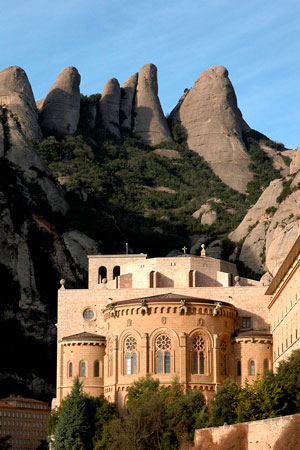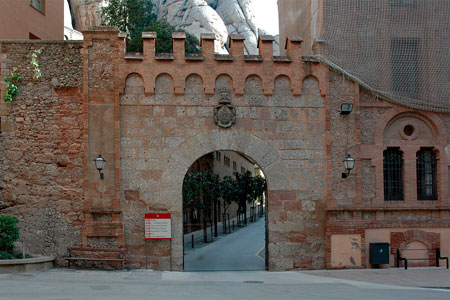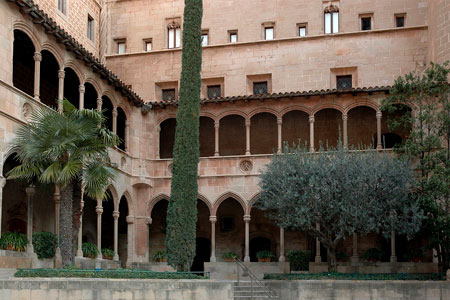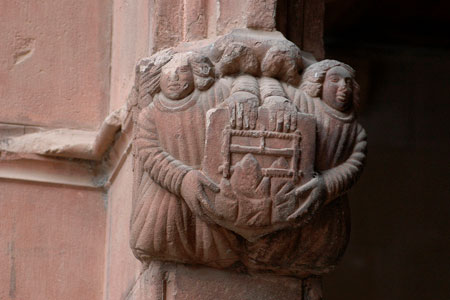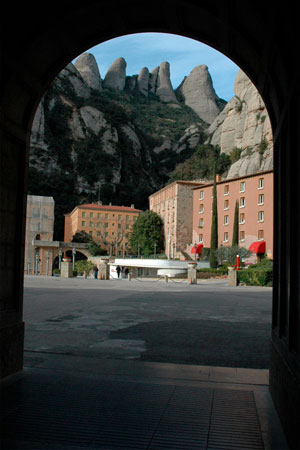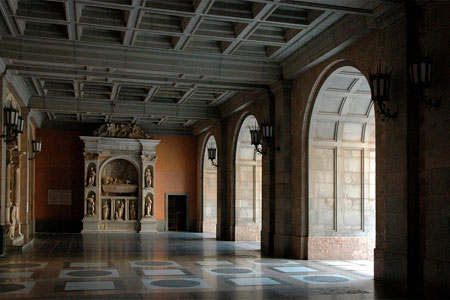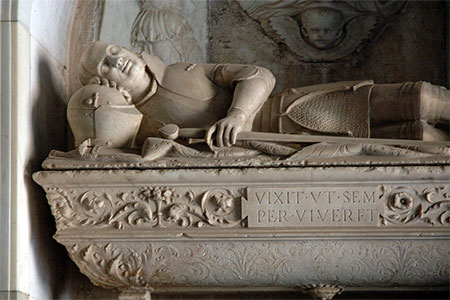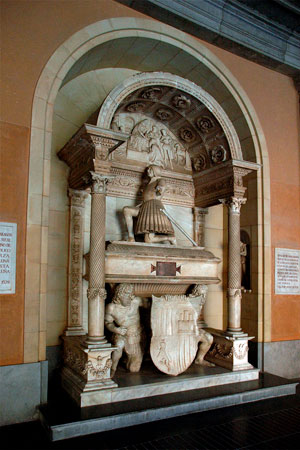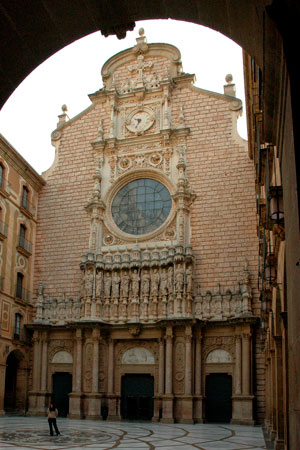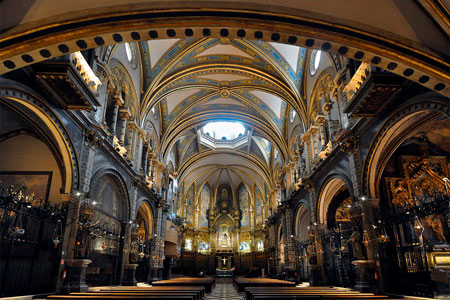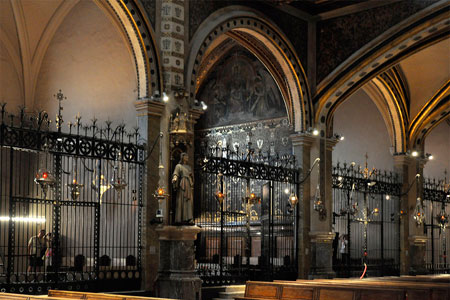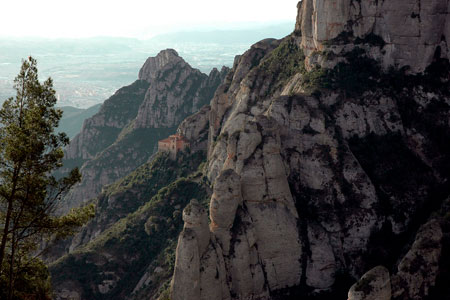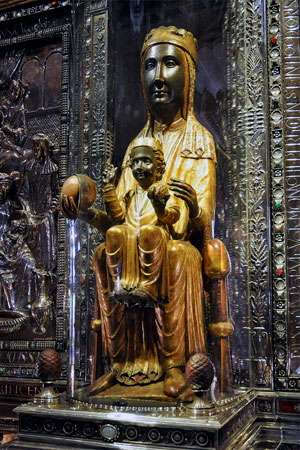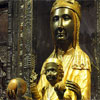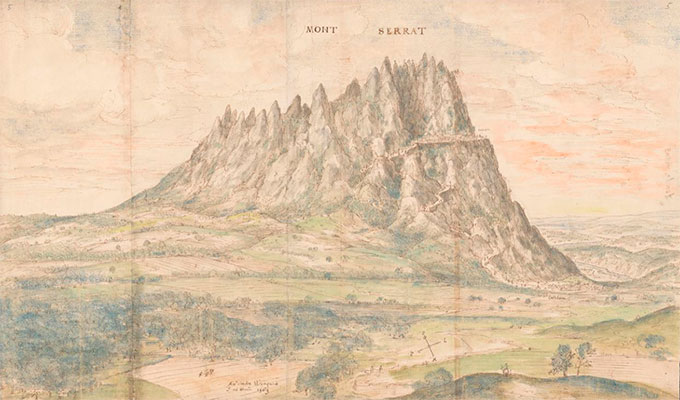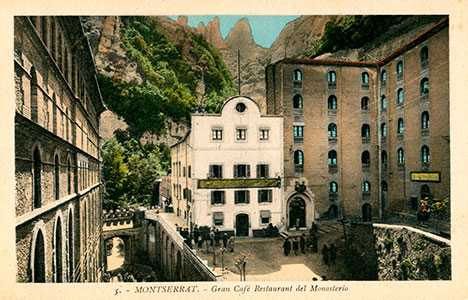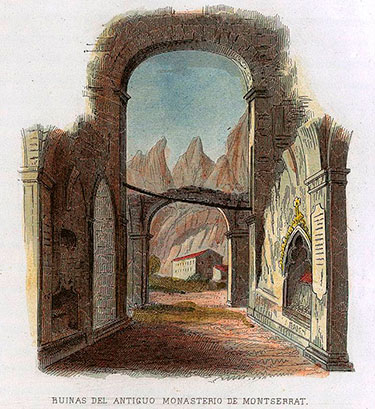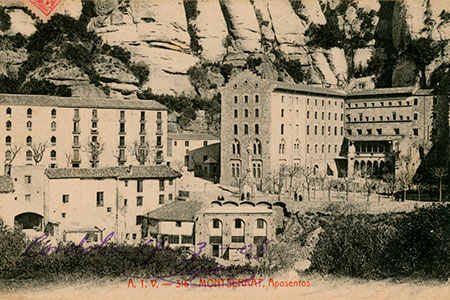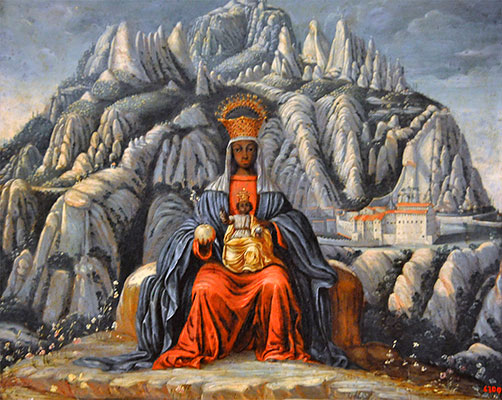Santa Maria de Montserrat Abbey
Montes Serrati / Abadia de Montserrat
(Monistrol de Montserrat, Bages)
Although the origin of this monastery has traditionally been traced back to some small centres of Visigoth tradition located on the mountain of Montserrat itself, there is no evidence to confirm this. It is known that after the recovery of this place from Islamic power, the counts of Barcelona made a donation to the monastery of Ripoll, possibly in the time of Guifré el Pelós (Wilfred the Hairy), in 888, and certainly his son Sunyer, in 933.
That donation included the churches of Santa Maria, Sant Iscle, Sant Pere and Sant Martí, with their boundaries. It should be noted that, at that time, the place of Santa Cecília, on the same mountain, which was more attractive to devotees at the time, was also in operation. Although it is quite possible that these churches were small monastic centers, Ripoll kept them as simple properties, like so many others. Oliba, the abbot of Ripoll, was forced to reclaim ownership of the churches in the face of Santa Cecília's attempts to take them over. This led to Santa Maria de Montserrat's monastic development.
There is no record of a foundation as such; all the evidence suggests that there was a small community, dependent on Ripoll. Nor is there any specific date, but the first record that makes explicit reference to this house is a donation made in 1019. Montserrat became a priory in 1070, when Ripoll became dependent on Saint-Victor of Marseille, while maintaining its link with Ripoll. From 1082 we find mention of the prior Ramon, the first at the head of this community, if we do not consider the superior abbots of Ripoll. This dependence was not an obstacle to the development of the center, accumulating properties, while devotion to the Virgin spread. This devotion was followed by the people and by the authorities, both civil, who protected the place, and by the ecclesiastical authorities.
In the 13th century, it still depended on Ripoll, with whom it had certain clashes. The prior of Montserrat was elected directly from that monastery. In 1287 the pope appointed Bernat Salvador, a monk from the abbey of Lagrasse (Languedoc), as the new prior of Montserrat, without Ripoll's intervention. This independence was apparent, since upon the death of Bernat Salvador both the pope and Ripoll appointed a successor on their own. The conflict with the duplicity of the post was resolved by the archbishop of Tarragona, leaving things as they were: submission to Ripoll. The prior Vicenç de Ribes was named cardinal and, apparently, at his request, Pope Benedict XIII succeeded in having Montserrat erected as an independent abbey in 1409.
In 1443, six monks from Montecassino joined the monastery with the aim of reforming it, but this was not accepted by the community; this situation continued until 1455. The abbey went through a period of decadence, although the works continued with the construction of a Gothic cloister. In 1493 the monastery was annexed to the congregation of San Benito de Valladolid, a subjection that lasted until 1811. In 1560 construction began on the basilica, which was consecrated in 1592, and construction continued with new buildings, an increase in properties and the establishment of dependent priories in many places. A printing press was set up, which over the years achieved great prestige. On the other hand, they accumulated an important artistic heritage. The Escolania choir also became very important.
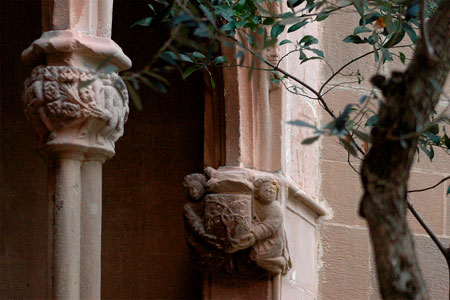
Cloister with the coat of arms of its promoter,
Abbot Giuliano della Rovere, later Pope Julius II
All of this was lost with the fire and destruction caused by the Peninsular War (1811-12) and subsequent robberies. Attempts were made to redress the situation, but the monks were forced to disperse and could not return until 1824. Afterwards, the disentailment stripped the monastery of its properties, which were auctioned off. The community returned in 1844 and in 1862 the pope appointed a new abbot, disassociating it from San Benito de Valladolid, which had also disappeared. Since then, and still today, it has been under the Benedictine congregation of Subiaco. It is a very important centre for the development of religious and civic life in Catalonia. The oldest remains of the monastery that have been found should be dated to around the 11th century, and a 12th-century portal has also been preserved. Apart from the church and the cloister, most of the buildings date from the 19th and 20th centuries.
Image of Our Lady of Montserrat
This image, which is highly venerated, is essentially a Romanesque work from the late 12th century, with Gothic features. Over time, modifications have been made, perhaps the most significant being the figure of the Child. It is a wooden piece that was painted black, giving it the distinctive appearance it is known for today.
- A. C. E. C. (1881). Álbum pintoresch-monumental de Catalunya. Vol. II. Montserrat. Barcelona (1881). Associació Catalanista d'Excursions Científicas
- ALBAREDA, Anselm M. (1922). Una història inèdita de Montserrat. Abadia de Montserrat
- ALBAREDA, Anselm M. (1931). Història de Montserrat. Monestir de Montserrat
- ALBAREDA, Anselm M. (1931). L'abat Oliva, fundador de Montserrat. Monestir de Montserrat
- BALDOMÀ, Joan (1945). Montserrat, montaña santa. Barcelona: Borrás
- BENET I CLARÀ, Albert (1984). Santa Maria de Montserrat. Catalunya romànica. Vol. XI. El Bages. Barcelona: Enciclopèdia Catalana
- CAMÓS, Narciso (1657). Jardín de Maria plantado en el Principado de Cataluña. Barcelona: Plantada
- CONEJO DA PENA, Antoni (2003). Els darrers claustres monàstics gòtics. L'art gòtic a Catalunya. Arquitectura II Catedrals, monestirs i altres edificis religiosos 2. Barcelona: Enciclopèdia Catalana
- CRUSELLAS, Francesc de Paula (1896). Nueva historia del santuario y monasterio de Nuestra Señora de Montserrat. Barcelona: Tip. Católica
- LAPLANA, Josep (2001). Montserrat, mil anys d'art i història. Manresa: Caixa Manresa
- MARTÍ, Juan (1877) . Historia de la imagen y santuario de Ntra. Sra. de Monserrat. Barcelona: Juan Roca
- MUNTADAS, Miguel (1867). Montserrat. Su pasado, su presente y su porvenir. Manresa: Pablo Roca
- ORDEIG I MATA, Ramon (1999): Catalunya carolíngia. Vol. IV Els comtats d’Osona i Manresa, 1ª part. Barcelona: I. Estudis Catalans
- RIBAS, Benet (1990). Història de Montserrat (888-1258). Barcelona: Curial; Abadia de Montserrat
- VERRIÉ, Frederic-Pau (1950). Montserrat. Madrid: Plus Ultra
- VILLANUEVA, Jaime (1821). Viage literario a las iglesias de España. Vol. VII. Viage a la Iglesia de Vique año 1806. Valencia: Oliveres


